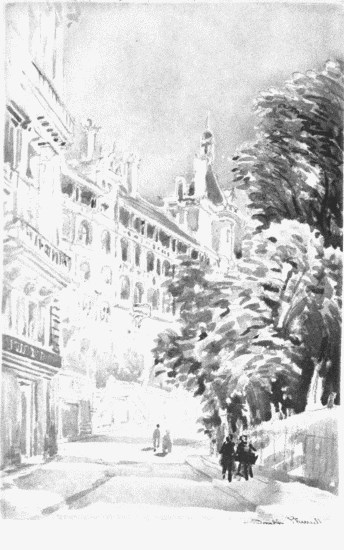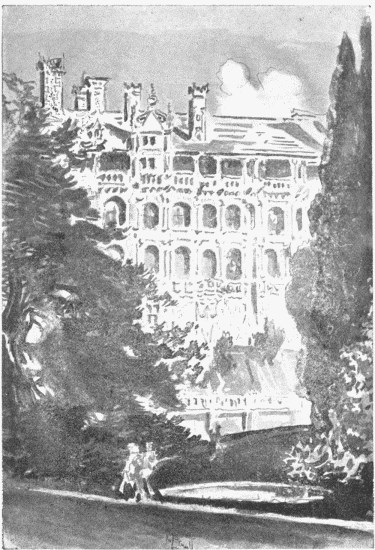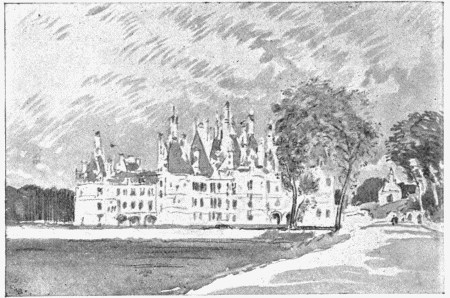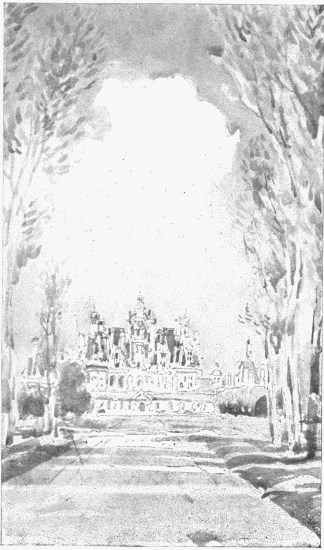
Генри Джеймс
A Little Tour of France

Chapter iv
Blois
YOUR business at Tours is to make excursions; and if you make them all you will be always under arms. The land is a rich reliquary, and an hour's drive from the town in almost any direction will bring you to the knowledge of some curious fragment of domestic or ecclesiastical architecture, some turreted manor, some lonely tower, some gabled village, some scene of something. Yet even if you do everything—which was not my case—you cannot hope to tell everything, and, fortunately for you, the excursions divide themselves into the greater and the less. You may achieve most of the greater in a week or two; but a summer in Touraine (which, by the way, must be a delectable thing) would hold none too many days for the others. If you come down to Tours from Paris your best economy is to spend a few days at Blois, where a clumsy but rather attractive little inn on the edge of the river will offer you a certain amount of that familiar and intermittent hospitality which a few weeks spent in the French provinces teaches you to regard as the highest attainable form of accommodation. Such an economy I was unable to practise. I could only go to Blois (from Tours) to spend the day; but this feat I accomplished twice over. It is a very sympathetic little town, as we say nowadays, and a week there would be sociable even without company. Seated on the north bank of the Loire, it presents a bright, clean face to the sun and has that aspect of cheerful leisure which belongs to all white towns that reflect themselves in shining waters. It is the water-front only of Blois, however, that exhibits this fresh complexion; the interior is of a proper brownness, as old sallow books are bound in vellum. The only disappointment is perforce the discovery that the castle, which is the special object of one's pilgrimage, does not overhang the river, as I had always allowed myself to understand. It overhangs the town, but is scarcely visible from the stream. That peculiar good fortune is reserved for Amboise and Chaumont.

BLOIS
The Château de Blois is one of the most beautiful and elaborate of all the old royal residences of this part of France, and I suppose it should have all the honours of my description. As you cross its threshold you step straight into the sunshine and storm of the French Renaissance. But it is too rich to describe—I can only pick out the high lights. It must be premised that in speaking of it as we see it to-day we speak of a monument unsparingly restored. The work of restoration has been as ingenious as it is profuse, but it rather chills the imagination. This is perhaps almost the first thing you feel as you approach the castle from the streets of the town. These little streets, as they leave the river, have pretensions to romantic steepness; one of them, indeed, which resolves itself into a high staircase with divergent wings (the escalier monumental), achieved this result so successfully as to remind me vaguely—I hardly know why—of the great slope of the Capitol, beside the Ara Cœli, at Rome. The view of that part of the castle which figures to-day as the back (it is the only aspect I had seen reproduced) exhibits the marks of restoration with the greatest assurance. The long façade, consisting only of balconied windows deeply recessed, erects itself on the summit of a considerable hill, which gives a fine, plunging movement to its foundations. The deep niches of the windows are all aglow with colour. They have been repainted with red and blue, relieved with gold figures; and each of them looks more like the royal box at a theatre than like the aperture of a palace dark with memories. For all this, however, and in spite of the fact that, as in some others of the châteaux of Touraine (always excepting the colossal Chambord, which is not in Touraine), there is less vastness than one had expected, the least hospitable aspect of Blois is abundantly impressive. Here, as elsewhere, lightness and grace are the keynote; and the recesses of the windows, with their happy proportions, their sculpture and their colour, are the hollow sockets of the human ornament. They need the figure of a Francis I. to complete them, or of a Diane de Poitiers, or even of a Henry III. The stand of this empty gilt cage emerges from a bed of light verdure which has been allowed to mass itself there and which contributes to the springing look of the walls; while on the right it joins the most modern portion of the castle, the building erected, on foundations of enormous height and solidity, in 1635, by Gaston d'Orléans. This fine frigid mansion—the proper view of it is from the court within—is one of the masterpieces of François Mansard, whom a kind providence did not allow to make over the whole palace in the superior manner of his superior age. That had been a part of Gaston's plan—he was a blunderer born, and this precious project was worthy of him. This execution of it would surely have been one of the great misdeeds of history. Partially performed, the misdeed is not altogether to be regretted; for as one stands in the court of the castle and lets one's eye wander from the splendid wing of Francis I.—which is the last word of free and joyous invention—to the ruled lines and blank spaces of the ponderous pavilion of Mansard, one makes one's reflections upon the advantage, in even the least personal of the arts, of having something to say, and upon the stupidity of a taste which had ended by becoming an aggregation of negatives. Gaston's wing, taken by itself, has much of the bel air which was to belong to the architecture of Louis XIV.; but, taken in contrast to its flowering, laughing, living neighbour, it marks the difference between inspiration and calculation. We scarcely grudge it its place, however, for it adds a price to the rest of the pile.

BLOIS—THE CHÂTEAU
We have entered the court, by the way, by jumping over the walls. The more orthodox method is to follow a modern terrace which leads to the left, from the side of the edifice that I began by speaking of, and passes round, ascending, to a little square on a considerably higher level, a square not, like the rather prosaic space on which the back (as I have called it) looks out, a thoroughfare. This small empty place, oblong in form, at once bright and quiet, and which ought to be grass-grown, offers an excellent setting to the entrance-front of the palace—the wing of Louis XII. The restoration here has been lavish; but it was perhaps but an inevitable reaction against the injuries, still more lavish, by which the unfortunate building had long been overwhelmed. It had fallen into a state of ruinous neglect, relieved only by the misuse proceeding from successive generations of soldiers, for whom its charming chambers served as barrack-room. Whitewashed, mutilated, dishonoured, the castle of Blois may be said to have escaped simply with its life. This is the history of Amboise as well, and is to a certain extent the history of Chambord. Delightful, at any rate, was the refreshed façade of Louis XII. as I stood and looked at it one bright September morning. In that soft, clear, merry light of Touraine, everything shows, everything speaks. Charming are the taste, the happy proportions, the colour of this beautiful front, to which the new feeling for a purely domestic architecture—an architecture of security and tranquillity, in which art could indulge itself—gave an air of youth and gladness. It is true that for a long time to come the castle of Blois was neither very safe nor very quiet; but its dangers came from within, from the evil passions of its inhabitants, and not from siege or invasion. The front of Louis XII. is of red brick, crossed here and there with purple; and the purple slate of the high roof, relieved with chimneys beautifully treated and with the embroidered caps of pinnacles and arches, with the porcupine of Louis, the ermine and the festooned rope which formed the devices of Anne of Brittany—the tone of this decorative roof carries out the mild glow of the wall. The wide, fair windows open as if they had expanded to let in the rosy dawn of the Renaissance. Charming, for that matter, are the windows of all the châteaux of Touraine, with their squareness corrected (as it is not in the Tudor architecture) by the curve of the upper corners, which gives this line the look, above the expressive aperture, of a pencilled eyebrow. The low door of this front is crowned by a high, deep niche, in which, under a splendid canopy, stiffly astride of a stiffly-draped charger, sits in profile an image of the good King Louis. Good as he had been—the father of his people, as he was called (I believe he remitted various taxes)—he was not good enough to pass muster at the Revolution; and the effigy I have just described is no more than a reproduction of the primitive statue demolished at that period.
Pass beneath it into the court, and the sixteenth century closes round you. It is a pardonable flight of fancy to say that the expressive faces of an age in which human passions lay very near the surface seem to peep out at you from the windows, from the balconies, from the thick foliage of the sculpture. The portion of the wing of Louis XII. that fronts toward the court is supported on a deep arcade. On your right is the wing erected by Francis I., the reverse of the mass of building which you see on approaching the castle. This exquisite, this extravagant, this transcendent piece of architecture is the most joyous utterance of the French Renaissance. It is covered with an embroidery of sculpture in which every detail is worthy of the hand of a goldsmith. In the middle of it, or rather a little to the left, rises the famous winding staircase (plausibly, but I believe not religiously, restored), which even the ages which most misused it must vaguely have admired. It forms a kind of chiselled cylinder, with wide interstices, so that the stairs are open to the air. Every inch of this structure, of its balconies, its pillars, its great central columns, is wrought over with lovely images, strange and ingenious devices, prime among which is the great heraldic salamander of Francis I. The salamander is everywhere at Blois—over the chimneys, over the doors, on the walls. This whole quarter of the castle bears the stamp of that eminently pictorial prince. The running cornice along the top of the front is like an unfolded, an elongated bracelet. The windows of the attic are like shrines for saints. The gargoyles, the medallions, the statuettes, the festoons are like the elaboration of some precious cabinet rather than the details of a building exposed to the weather and to the ages. In the interior there is a profusion of restoration, and it is all restoration in colour. This has been, evidently, a work of great energy and cost, but it will easily strike you as overdone. The universal freshness is a discord, a false note; it seems to light up the dusky past with an unnatural glare. Begun in the reign of Louis Philippe, this terrible process—the more terrible always the better case you conceive made out for it—has been carried so far that there is now scarcely a square inch of the interior that preserves the colour of the past. It is true that the place had been so coated over with modern abuse that something was needed to keep it alive; it is only perhaps a pity the clever doctors, not content with saving its life, should have undertaken to restore its bloom. The love of consistency, in such a business, is a dangerous lure. All the old apartments have been rechristened, as it were; the geography of the castle has been re-established. The guard-rooms, the bedrooms, the closets, the oratories have recovered their identity. Every spot connected with the murder of the Duke of Guise is pointed out by a small, shrill boy, who takes you from room to room and who has learned his lesson in perfection. The place is full of Catherine de'Medici, of Henry III., of memories, of ghosts, of echoes, of possible evocations and revivals. It is covered with crimson and gold. The fireplaces and the ceilings are magnificent; they look like expensive "sets" at the grand opera.
I should have mentioned that below, in the court, the front of the wing of Gaston d'Orléans faces you as you enter, so that the place is a course of French history. Inferior in beauty and grace to the other portions of the castle, the wing is yet a nobler monument than the memory of Gaston deserves. The second of the sons of Henry IV.—who was no more fortunate as a father than as a husband—younger brother of Louis XIII. and father of the great Mademoiselle, the most celebrated, most ambitious, most self-complacent and most unsuccessful fille à marier in French history, passed in enforced retirement at the castle of Blois the close of a life of clumsy intrigues against Cardinal Richelieu, in which his rashness was only equalled by his pusillanimity and his ill-luck by his inaccessibility to correction, and which, after so many follies and shames, was properly summed up in the project—begun, but not completed—of demolishing the beautiful habitation of his exile in order to erect a better one. With Gaston d'Orléans, however, who lived there without dignity, the history of the Château de Blois declines. Its interesting period is that of the wars of religion. It was the chief residence of Henry III., and the scene of the principal events of his depraved and dramatic rule. It has been restored more than enough, as I have said, by architects and decorators; the visitor, as he moves through its empty rooms, which are at once brilliant and ill-lighted (they have not been refurnished), undertakes a little restoration of his own. His imagination helps itself from the things that remain; he tries to see the life of the sixteenth century in its form and dress—its turbulence, its passions, its loves and hates, its treacheries, falsities, sincerities, faith, its latitude of personal development, its presentation of the whole nature, its nobleness of costume, charm of speech, splendour of taste, unequalled picturesqueness. The picture is full of movement, of contrasted light and darkness, full altogether of abominations. Mixed up with them all is the great theological motive, so that the drama wants little to make it complete. What episode was ever more perfect—looked at as a dramatic occurrence—than the murder of the Duke of Guise? The insolent prosperity of the victim; the weakness, the vices, the terrors, of the author of the deed; the perfect execution of the plot; the accumulation of horror in what followed it—render it, as a crime, one of the classic things.
But we must not take the Château de Blois too hard: I went there, after all, by way of entertainment. If among these sinister memories your visit should threaten to prove a tragedy, there is an excellent way of removing the impression. You may treat yourself at Blois to a very cheerful afterpiece. There is a charming industry practised there, and practised in charming conditions. Follow the bright little quay down the river till you get quite out of the town and reach the point where the road beside the Loire becomes sinuous and attractive, turns the corner of diminutive headlands and makes you wonder what is beyond. Let not your curiosity induce you, however, to pass by a modest white villa which overlooks the stream, enclosed in a fresh little court; for here dwells an artist—an artist in faience. There is no sort of sign, and the place looks peculiarly private. But if you ring at the gate you will not be turned away. You will, on the contrary, be ushered upstairs into a parlour—there is nothing resembling a shop—encumbered with specimens of remarkably handsome pottery. The ware is of the best, a careful reproduction of old forms, colours, devices; and the master of the establishment is one of those completely artistic types that are often found in France. His reception is as friendly as his work is ingenious; and I think it is not too much to say that you like the work better because he has produced it. His vases, cups and jars, lamps, platters, plaques, with their brilliant glaze, their innumerable figures, their family likeness and wide variations, are scattered through his occupied rooms; they serve at once as his stock-in-trade and as household ornament. As we all know, this is an age of prose, of machinery, of wholesale production, of coarse and hasty processes. But one brings away from the establishment of the very intelligent M. Ulysse the sense of a less eager activity and a greater search for perfection. He has but a few workmen and he gives them plenty of time. The place makes a little vignette, leaves an impression—the quiet white house in its garden on the road by the wide, clear river, without the smoke, the bustle, the ugliness, of so much of our modern industry. It struck me as an effort Mr. Ruskin might have inspired and Mr. William Morris—though that be much to say—have forgiven.

Chapter v
Chambord
THE second time I went to Blois I took a carriage for Chambord, and came back by the Château de Cheverny and the forest of Russy—a charming little expedition, to which the beauty of the afternoon (the finest in a rainy season that was spotted with bright days) contributed not a little. To go to Chambord you cross the Loire, leave it on one side and strike away through a country in which salient features become less and less numerous and which at last has no other quality than a look of intense and peculiar rurality—the characteristic, even when it be not the charm, of so much of the landscape of France. This is not the appearance of wildness, for it goes with great cultivation; it is simply the presence of the delving, drudging, economising peasant. But it is a deep, unrelieved rusticity. It is a peasant's landscape; not, as in England, a landlord's. On the way to Chambord you enter the flat and sandy Sologne. The wide horizon opens out like a great potager, without interruptions, without an eminence, with here and there a long, low stretch of wood. There is an absence of hedges, fences, signs of property; everything is absorbed in the general flatness—the patches of vineyard, the scattered cottages, the villages, the children (planted and staring and almost always pretty), the women in the fields, the white caps, the faded blouses, the big sabots. At the end of an hour's drive (they assure you at Blois that even with two horses you will spend double that time), I passed through a sort of gap in a wall which does duty as the gateway of the domain of a proscribed pretender. I followed a straight avenue through a disfeatured park—the park of Chambord has twenty-one miles of circumference; a very sandy, scrubby, melancholy plantation, in which the timber must have been cut many times over and is to-day a mere tangle of brushwood. Here, as in so many spots in France, the traveller perceives that he is in a land of revolutions. Nevertheless its great extent and the long perspective of its avenues give this frugal shrubbery a certain state; just as its shabbiness places it in agreement with one of the strongest impressions awaiting you. You pursue one of these long perspectives a proportionate time, and at last you see the chimneys and pinnacles of Chambord rise apparently out of the ground. The filling-in of the wide moats that formerly surrounded it has, in vulgar parlance, let it down and given it a monstrous over-crowned air that is at the same time a magnificent Orientalism. The towers, the turrets, the cupolas, the gables, the lanterns, the chimneys look more like the spires of a city than the salient points of a single building. You emerge from the avenue and find yourself at the foot of an enormous fantastic mass. Chambord has a strange mixture of society and solitude. A little village clusters within view of its liberal windows, and a couple of inns near by offer entertainment to pilgrims. These things of course are incidents of the political proscription which hangs its thick veil over the place. Chambord is truly royal—royal in its great scale, its grand air, its indifference to common considerations. If a cat may look at a king, a tavern may look at a palace. I enjoyed my visit to this extraordinary structure as much as if I had been a legitimist; and indeed there is something interesting in any monument of a great system, any bold presentation of a tradition.
You leave your vehicle at one of the inns, which are very decent and tidy and in which every one is very civil, as if in this latter respect the neighbourhood of a Court veritably set the fashion, and you proceed across the grass and the gravel to a small door, a door infinitely subordinate and conferring no title of any kind on those who enter it. Here you ring a bell, which a highly respectable person answers (a person perceptibly affiliated, again, to the old regime), after which she ushers you over a vestibule into an inner court. Perhaps the strongest impression I got at Chambord came to me as I stood in this court. The woman who admitted me did not come with me; I was to find my guide somewhere else. The specialty of Chambord is its prodigious round towers. There are, I believe, no less than eight of them, placed at each angle of the inner and outer square of buildings; for the castle is in the form of a larger structure which encloses a smaller one. One of these towers stood before me in the court; it seemed to fling its shadow over the place; while above, as I looked up, the pinnacles and gables, the enormous chimneys, soared into the bright blue air. The place was empty and silent; shadows of gargoyles, of extraordinary projections, were thrown across the clear grey surfaces. One felt that the whole thing was monstrous. A cicerone appeared, a languid young man in a rather shabby livery, and led me about with a mixture of the impatient and the desultory, of condescension and humility. I do not profess to understand the plan of Chambord, and I may add that I do not even desire to do so; for it is much more entertaining to think of it, as you can so easily, as an irresponsible, insoluble labyrinth. Within it is a wilderness of empty chambers, a royal and romantic barrack. The exiled prince to whom it gives its title has not the means to keep up four hundred rooms; he contents himself with preserving the huge outside. The repairs of the prodigious roof alone must absorb a large part of his revenue. The great feature of the interior is the celebrated double staircase, rising straight through the building, with two courses of steps, so that people may ascend and descend without meeting. This staircase is a truly majestic piece of humour; it gives you the note, as it were, of Chambord. It opens on each landing to a vast guard-room, in four arms, radiations of the winding shaft. My guide made me climb to the great open-work lantern which, springing from the roof at the termination of the rotund staircase (surmounted here by a smaller one), forms the pinnacle of the bristling crown of the pile. This lantern is tipped with a huge fleur-de-lis in stone—the only one, I believe, that the Revolution did not succeed in pulling down. Here, from narrow windows, you look over the wide, flat country and the tangled, melancholy park, with the rotation of its straight avenues. Then you walk about the roof in a complication of galleries, terraces, balconies, through the multitude of chimneys and gables. This roof, which is in itself a sort of castle in the air, has an extravagant, fabulous quality, and with its profuse ornamentation—the salamander of Francis I. is a constant motive—its lonely pavements, its sunny niches, the balcony that looks down over the closed and grass-grown main entrance, a strange, half-sad, half-brilliant charm. The stonework is covered with fine mould. There are places that reminded me of some of those quiet mildewed corners of courts and terraces into which the traveller who wanders through the Vatican looks down from neglected windows. They show you two or three furnished rooms, with Bourbon portraits, hideous tapestries from the ladies of France, a collection of the toys of the enfant du miracle, all military and of the finest make. "Tout cela fonctionne," the guide said of these miniature weapons; and I wondered, if he should take it into his head to fire off his little cannon, how much harm the Comte de Chambord would do.

From below the castle would look crushed by the redundancy of its upper protuberances if it were not for the enormous girth of its round towers, which appear to give it a robust lateral development. These towers, however, fine as they are in their way, struck me as a little stupid; they are the exaggeration of an exaggeration. In a building erected after the days of defence and proclaiming its peaceful character from its hundred embroideries and cupolas, they seem to indicate a want of invention. I shall risk the accusation of bad taste if I say that, impressive as it is, the Château de Chambord seemed to me to have altogether a touch of that quality of stupidity. The trouble is that it stands for nothing very momentous; it has not happened, in spite of sundry vicissitudes, to have a strongly-marked career. Compared with that of Blois and Amboise its past is rather vacant; and one feels to a certain extent the contrast between its pompous appearance and its spacious but somewhat colourless annals. It had indeed the good fortune to be erected by Francis I., whose name by itself expresses a good deal of history. Why he should have built a palace in those sandy plains will ever remain an unanswered question, for kings have never been obliged to give reasons. In addition to the fact that the country was rich in game and that Francis was a passionate hunter, it is suggested by M. de la Saussaye, the author of the very complete little account of the place which you may buy at the bookseller's at Blois, that he was governed in his choice of the site by the chance that a charming woman had previously lived there. The Comtesse de Thoury had a manor in the neighbourhood, and the Comtesse de Thoury had been the object of a youthful passion on the part of the most susceptible of princes before his accession to the throne. This great pile was reared, therefore, according to M. de la Saussaye, as a souvenir de premières amours! It is certainly a very massive memento; and if these tender passages were proportionate to the building that commemorates them, the flame blazed indeed. There has been much discussion as to the architect employed by Francis I., and the honour of having designed this splendid residence has been claimed for several of the Italian artists who early in the sixteenth century came to seek patronage in France. It seems well established to-day, however, that Chambord was the work neither of Primaticcio, of Vignola, nor of Il Rosso, all of whom have left some trace of their sojourn in France; but of an obscure yet very complete genius, Pierre Nepveu, known as Pierre Trinqueau, who is designated in the papers which preserve in some degree the history of the origin of the edifice, as the maistre de l'œuvre de maçonnerie. Behind this modest title, apparently, we must recognise one of the most original talents of the French Renaissance; and it is a proof of the vigour of the artistic life of that period that, brilliant production being everywhere abundant, an artist of so high a value should not have been treated by his contemporaries as a celebrity. We make our celebrities to-day at smaller cost.
The immediate successors of Francis I. continued to visit Chambord; but it was neglected by Henry IV. and was never afterwards a favourite residence of any French king. Louis XIV. appeared there on several occasions, and the apparition was characteristically brilliant; but Chambord could not long detain a monarch who had gone to the expense of creating a Versailles ten miles from Paris. With Versailles, Fontainebleau, Saint-Germain and Saint-Cloud within easy reach of their capital, the later French sovereigns had little reason to take the air in the dreariest province of their kingdom. Chambord therefore suffered from royal indifference, though in the last century a use was found for its deserted halls. In 1725 it was occupied by the luckless Stanislaus Leczynski, who spent the greater part of his life in being elected King of Poland and being ousted from his throne, and who, at this time a refugee in France, had found a compensation for some of his misfortunes in marrying his daughter to Louis XV. He lived eight years at Chambord and filled up the moats of the castle. In 1748 it found an illustrious tenant in the person of Maurice de Saxe, the victor of Fontenoy, who, however, two years after he had taken possession of it, terminated a life which would have been longer had he been less determined to make it agreeable. The Revolution, of course, was not kind to Chambord. It despoiled it in so far as possible of every vestige of its royal origin, and swept like a whirlwind through apartments to which upwards of two centuries had contributed a treasure of decoration and furniture. In that wild blast these precious things were destroyed or for ever scattered. In 1791 an odd proposal was made to the French Government by a company of English Quakers, who had conceived the bold idea of establishing in the palace a manufacture of some peaceful commodity not to-day recorded. Napoleon allotted Chambord, as a "dotation," to one of his marshals, Berthier, for whose benefit it was converted, in Napoleonic fashion, into the so-called principality of Wagram. By the Princess of Wagram, the marshal's widow, it was, after the Restoration, sold to the trustees of a national subscription which had been established for the purpose of presenting it to the infant Duke of Bordeaux, then prospective King of France. The presentation was duly made; but the Comte de Chambord, who had changed his title in recognition of the gift, was despoiled of his property by the government of Louis Philippe. He appealed for redress to the tribunals of his country; and the consequence of his appeal was an interminable litigation, by which, however, finally, after the lapse of twenty-five years, he was established in his rights. In 1871 he paid his first visit to the domain which had been offered him half a century before, a term of which he had spent forty years in exile. It was from Chambord that he dated his famous letter of the 5th of July of that year—the letter, directed to his so-called subjects, in which he waves aloft the white flag of the Bourbons. This rare miscalculation—virtually an invitation to the French people to repudiate, as their national ensign, that immortal tricolour, the flag of the Revolution and the Empire, under which they have won the glory which of all glories has hitherto been dearest to them and which is associated with the most romantic, the most heroic, the epic, the consolatory, period of their history—this luckless manifesto, I say, appears to give the measure of the political wisdom of the excellent Henry V. The proposal should have had less simplicity or the people less irony.






